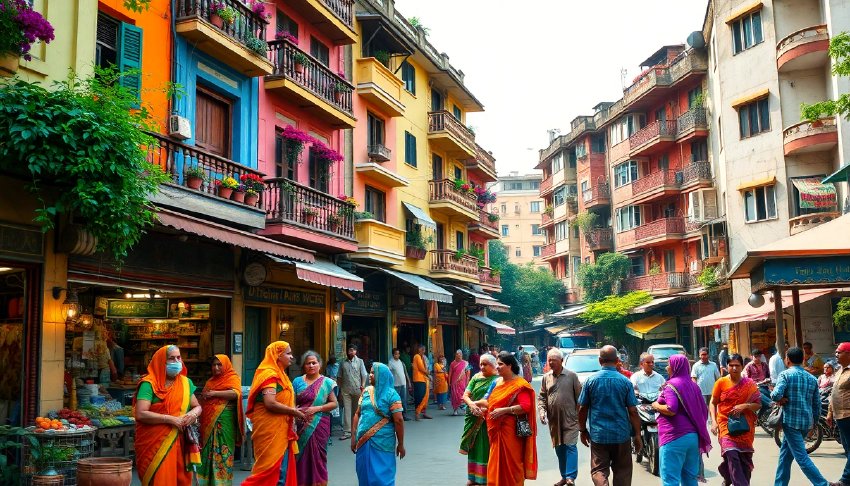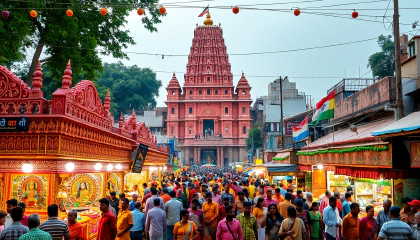
C.R. Park: Delhi's Bengali Enclave Thrives Amid Urbanization
C.R. Park: A Living Legacy of Bengali Culture Amidst Delhi’s Urbanization
Chittaranjan Park, or C.R. Park, stands as a vibrant testament to the resilience of Bengali culture in the heart of India’s bustling capital. This unique neighborhood in South Delhi exemplifies how ethnic enclaves can thrive and evolve while preserving their cultural heritage amidst rapid urbanization. From its humble beginnings as a refugee settlement to its current status as a cultural hotspot, C.R. Park’s journey offers fascinating insights into community dynamics, urban planning, and cultural preservation in modern India.
The Historical Tapestry of C.R. Park
From Refugee Settlement to Cultural Haven
C.R. Park’s story begins in the aftermath of India’s partition in 1947. Originally known as the East Pakistan Displaced Persons (EPDP) Colony, it was established in the early 1960s to accommodate Bengali refugees fleeing from East Pakistan (now Bangladesh). The area, once a rocky, barren landscape, transformed into a thriving community through the determination and cultural tenacity of its residents.
Evolution of a Bengali Enclave
Over the decades, C.R. Park evolved from a simple refugee settlement into a sophisticated urban neighborhood. The transition from EPDP Colony to Purbachal, and finally to Chittaranjan Park in the 1980s, mirrors the community’s journey from displacement to establishment. Today, it stands as a prime example of how cultural identity can be maintained and celebrated within the broader urban fabric of a diverse metropolis.
Cultural Dynamics in an Urban Setting
Preserving Bengali Traditions
C.R. Park has become synonymous with Bengali culture in Delhi. The neighborhood’s calendar is punctuated by vibrant celebrations of Bengali festivals, most notably the grand Durga Puja festivities. These events not only serve as a cultural anchor for the Bengali community but also attract visitors from across Delhi, fostering intercultural understanding and appreciation.
Culinary Heritage as a Cultural Bridge
One of C.R. Park’s most beloved features is its food scene. The area’s markets and food stalls offer an authentic taste of Bengali cuisine, from street food like phuchka and jhal muri to sweets like rasgulla and sandesh. This culinary landscape serves as both a nostalgic comfort for Bengali residents and an introduction to Bengali culture for others, effectively bridging cultural gaps through gastronomy.
Architectural and Spatial Transformation
From Single-Story Homes to Modern Apartments
C.R. Park’s physical landscape has undergone significant changes over the years. The original single-story homes, reminiscent of traditional Bengali architecture, have gradually given way to multi-story apartments. This transformation reflects both the increasing property values in South Delhi and the changing needs of the community. Despite these changes, efforts have been made to retain elements of Bengali architectural aesthetics in many buildings.
Community Spaces as Cultural Anchors
The neighborhood’s layout includes numerous parks, community centers, and cultural institutions that serve as focal points for social interaction and cultural activities. Spaces like the Bangiya Samaj and various temples not only preserve Bengali traditions but also adapt to serve the evolving needs of a diverse community. These spaces play a crucial role in maintaining the area’s cultural identity while fostering inclusivity.
Socio-Economic Dynamics and Cultural Resilience
Demographic Shifts and Integration
While C.R. Park was initially established exclusively for Bengali refugees, it has gradually become more diverse. The influx of non-Bengali residents has led to an interesting cultural amalgamation. This demographic shift presents both challenges and opportunities for cultural preservation and integration.
Economic Evolution and Its Cultural Impact
C.R. Park’s transformation from a refugee settlement to an upscale neighborhood in South Delhi has had profound economic implications. The rising property values and changing economic profile of residents have influenced the area’s cultural landscape. However, the community has shown remarkable adaptability, finding ways to preserve its cultural essence while embracing economic progress.
Conclusion: A Model of Cultural Preservation in Urban India
Chittaranjan Park stands as a compelling example of how ethnic communities can preserve their cultural identity while adapting to urban pressures. Its journey from a refugee settlement to a vibrant cultural enclave offers valuable lessons in urban planning, community building, and cultural preservation. As Delhi continues to grow and evolve, C.R. Park remains a living legacy of Bengali culture, demonstrating how ethnic resilience and community spirit can thrive amidst the challenges of urbanization. The neighborhood’s ability to maintain its cultural essence while embracing change makes it a unique and vital part of Delhi’s diverse tapestry, offering a model for other ethnic enclaves in rapidly urbanizing environments across India and beyond.





